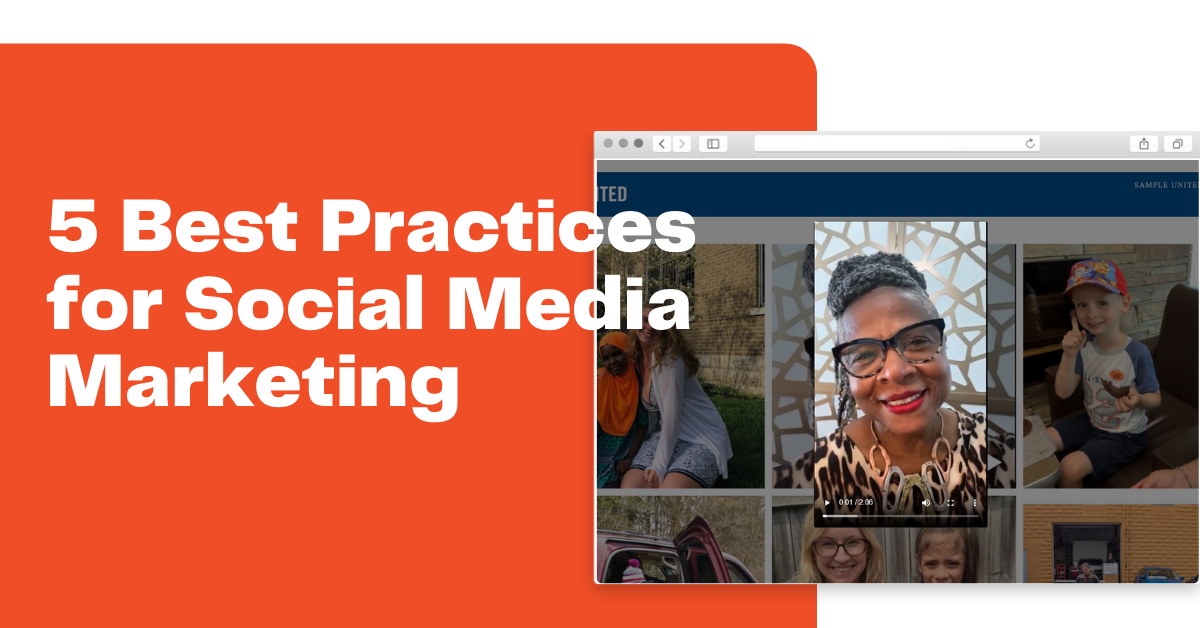5 Best Practices for Social Media Marketing

Social media – love it or hate it, it is here to stay. Whether you use it personally to scroll on your phone or use it to promote your nonprofit’s services, social media likely touches your life in some capacity (you’re reading this article, aren’t you?). In 2022, you simply can’t have marketing without including social media. Any marketing strategy will need to have a separate segment for a social media strategy, but proper social media planning for any business or organizational objective goes beyond a simple post on Instagram or Facebook.
What is Social Media Marketing?
HubSpot defines Social Media Marketing as “the process of creating content for social media platforms to promote your products and/or services, build community with your target audience, and drive traffic to your business.” However, the capabilities of social media stretch far beyond organic content creation. Social media platforms have built in analytical tools, targeted advertisement software, and even capabilities like A/B testing. To only create a social media marketing strategy around organic content – that is, taking a picture and posting it to your channel with a caption – is not taking full advantage of what these platforms have to offer your nonprofit.
Quick Definitions: Organic vs. Paid Social Media
To drill down into it a bit more, organic social media is posting pictures, articles, or text on your platforms for free. This aspect of social media marketing requires no monetary investment to promote your nonprofit’s services, volunteers, or donors. However, organic posting alone won’t boost your content enough to extend your reach and bump your posts to the top of the algorithms.
In contrast, paid advertisements on social media performs well on their own if executed correctly. Simply put, paid social media is supporting your content with an advertising budget. You can support an organic post with a paid “boost” that amplifies the post to a pre-made targeted audience. With a budget behind it, this once-organic post now drives to the top of the algorithm for individuals or accounts that meet the criteria for the targeted audience that you created for your nonprofit. Beyond supporting organic posts with a paid boost, you can also create ads themselves and have them strategically placed across multiple social media platforms in order to spread awareness of your services, promote an event, or even gain traction in a thank-a-donor campaign. Paid social media has the capability to help achieve most business, operational, or marketing objectives!
We know that as a nonprofit organization, paid social media may not be in the budget to be at the forefront of your social media marketing strategies. In light of this, we’ve compiled a list of several ways including paid advertising to make the most out of your social media marketing!
Make the Most of Social Media Marketing
- Post valuable and consistent contentEven without a budget to support your content, organic posts can still reach a wide audience with consistency if the content itself provides some sort of value. Can your audience learn something new in a Tweet or Instagram post? Can you tell an inspiring story that will make your followers, and their followers, share it across Facebook? Can you entertain your audience with stories of your staff behind-the-scenes, or a dog in the office?You don’t want to spend all of your time and effort only promoting your services, thanking volunteers, or soliciting donors. Even though you’re not necessarily selling a product in these instances, your platforms will feel like one big sales pitch if you don’t switch up your content to be something that is valuable in itself. If your content is insightful, inspiring, or entertaining, it’s more likely to be shared across the interest to extend your reach beyond those who follow your account. And extending your reach will promote your brand awareness, and likely increase the number of followers you have on your channels!
- Determine your KPI’s based on your goalsIf marketing goals begin with business or operational goals, then social media goals begin with marketing goals. Take a step back from your social media planning and think on a larger scale: what do you want to achieve with your marketing plan? Are you trying to spread awareness of your goals, or are you focusing on collecting emails for your database? The objective behind your goal will help you determine what your key performance indicators are for your social media marketing plan. For example, if your objective is to spread awareness about your nonprofit organization and the services that you provide, your KPI’s might be number of impressions, organic reach, and number of followers. But if you are campaigning to collect more emails for your database, you’re likely going to prefer number of clicks, CTR (click through rate), or post engagement for your social media KPI’s.Of course, you can have multiple KPI’s for social media marketing, just as you can have multiple objectives and campaign strategies! Your KPI’s give you a concrete way to track and analyze how you’re doing in achieving your goals through social media. If your KPI’s aren’t performing as well as you would like, then you know that it’s time to alter your strategy!
- Engage with followersThis one is both easy and free, but it comes with the caveat of potentially being time consuming. Engaging with your followers in the comments on your posts – or theirs – not only keeps your nonprofit at the top of mind for your audience, but also maintains a positive reputation for your brand. You can further build your reputation and engage with your audience by sharing others’ content to your account through retweets, Instagram stories, or even directly to your Facebook or LinkedIn pages.
- Support social media with an advertising budgetPromoting your content or brand with paid social media advertising is one way to get around the algorithm and spread your message far and wide, but at a price. To best take advantage of this, you should build audiences in platforms like Facebook Business Suite that would target who you want to see your content. Do you want everyone in a specific area to see your posts, or just those who are interested in something specific? You can create an audience to target a number of things, and use a budget to increase your chances that these accounts will see your message.
- Use videos to boost your contentYou’ve probably heard this before, but video content performs best in the algorithms built in the social media platforms. Switch up your routine organic content and post a video or two, even a small one! Boosting your post to the top of the feed will make more people see it, which can help you meet your marketing objectives.
For tips about how to best make use of video on social media, check out our article for 5 Video Storytelling Techniques!
Social media marketing is a strategic way to meet your audience where they live on the internet to promote your brand or services. It’s a valuable tool to meet your marketing goals, and with the right preparation, you can make the most of your social media marketing!
Want to have more nonprofit marketing tips and best practices emailed straight to you? Sign up for our monthly newsletter!




